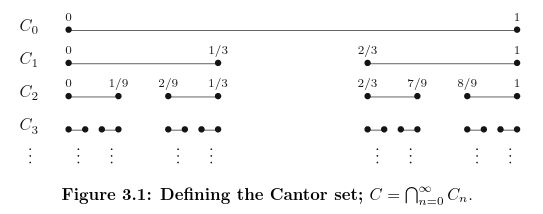Math and science::Analysis
The Cantor Set
The Cantor set is important for understanding Topology (open and closed sets) and measure.
Cantor set
Let \( C_0 \) be the closed interval \( [0, 1] \) and define \( C_1 \) to be the set that results when the open middle third is removed:
[\[ C_1 = \; C_0 \setminus \; ? = \;\; ?\; \cup \; ? \]]
This process continued gives us the Cantor set:
\[
C = \bigcap_{n=0}^{\infty} C_n
\]
Or alternatively:
[\[ C = [0,1] \setminus \big( (\frac{1}{3},\frac{2}{3}) \; \cup \; (?,\,?) \; \cup \; (?,\,?) \; \cup \; ...\big) \] ]

Properties of the Cantor set
Below are some properties of the Cantor set, with explanations on the reverse side.
The cantor set...
- has [zero/finite/infinite] measure
- is [countably/uncountably] infinite
- has dimension of [...]
- is [open/closed/neither/both]
- is [compact/not compact]
- is [perfect/not perfect]
- is [...] dense
